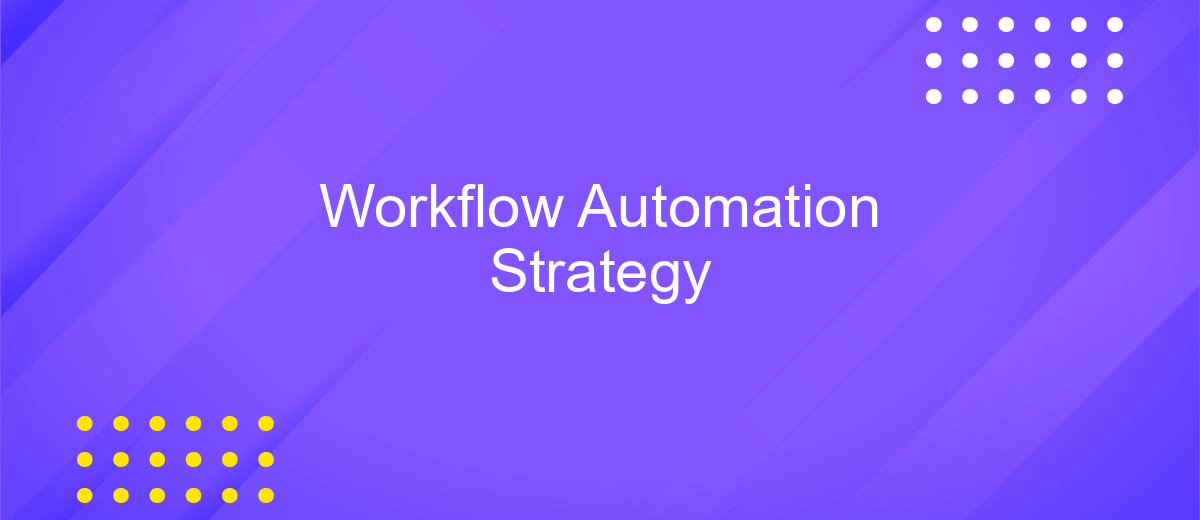Workflow Automation Strategy
In today's fast-paced business environment, optimizing efficiency and productivity is crucial. A well-crafted workflow automation strategy can significantly streamline operations, reduce human error, and enhance overall performance. This article explores key elements of developing an effective workflow automation strategy, offering insights and practical tips to help businesses harness the full potential of automation technologies.
Introduction
In today's fast-paced business environment, workflow automation has become a critical component for enhancing productivity and efficiency. By automating repetitive tasks, organizations can focus on more strategic activities, thus driving growth and innovation. A well-defined workflow automation strategy can streamline operations, reduce errors, and save valuable time and resources.
- Identify repetitive and time-consuming tasks
- Select appropriate automation tools
- Integrate systems and applications seamlessly
- Monitor and optimize automated workflows
One of the key aspects of a successful workflow automation strategy is the integration of various systems and applications. Tools like ApiX-Drive facilitate seamless integration, enabling businesses to connect different software solutions without the need for complex coding. By leveraging such services, organizations can ensure that their workflow automation processes are efficient and scalable, ultimately leading to better performance and outcomes.
Benefits of Workflow Automation

Implementing workflow automation can significantly enhance operational efficiency by reducing the time spent on repetitive tasks. This allows employees to focus on more strategic activities that require human intervention, ultimately boosting productivity and job satisfaction. Automation also minimizes the risk of human error, ensuring that processes are executed with consistent accuracy, which is crucial for maintaining high-quality standards and compliance.
Moreover, workflow automation facilitates seamless integration between various software and systems. Tools like ApiX-Drive enable businesses to connect different applications effortlessly, streamlining data flow and improving communication across departments. This integration capability not only saves time but also provides real-time insights, empowering decision-makers with accurate and up-to-date information. By leveraging such automation tools, organizations can achieve greater agility and responsiveness in an increasingly competitive market.
Key Considerations for a Successful Strategy

When developing a workflow automation strategy, several key considerations can significantly impact its success. A well-thought-out plan ensures that the automation aligns with business goals, optimizes processes, and delivers measurable results.
- Define Clear Objectives: Establish specific, measurable goals for what you aim to achieve with automation. This could include reducing manual tasks, improving accuracy, or enhancing productivity.
- Choose the Right Tools: Select automation tools that fit your business needs. Platforms like ApiX-Drive can help streamline integrations and automate workflows without requiring extensive coding knowledge.
- Assess and Optimize Processes: Evaluate current workflows to identify inefficiencies and areas for improvement. Automate repetitive tasks and ensure that the new processes are optimized for better performance.
- Ensure Scalability: Implement solutions that can grow with your business. Your automation strategy should be flexible enough to accommodate future needs and changes in scale.
- Monitor and Adjust: Continuously monitor the performance of automated workflows and make necessary adjustments. Use analytics to measure success and identify areas for further optimization.
By considering these factors, businesses can develop a robust workflow automation strategy that not only meets current needs but also positions them for future growth and efficiency.
Implementation and Management

Implementing a workflow automation strategy involves careful planning and execution. Begin by identifying the processes that can be automated and the tools that best fit your organization's needs. Establish clear objectives and metrics to measure the success of your automation efforts.
Once you have a plan in place, it's crucial to manage the implementation effectively. This includes setting timelines, assigning responsibilities, and ensuring that all stakeholders are on board. Regularly review progress and make adjustments as needed to stay on track.
- Identify key processes for automation
- Select appropriate tools and platforms
- Set clear objectives and metrics
- Assign responsibilities and set timelines
- Regularly review and adjust the plan
For seamless integration of various tools and platforms, consider using services like ApiX-Drive. This service allows you to easily connect different applications and automate workflows without requiring extensive technical knowledge. By leveraging such tools, you can ensure a smoother implementation and more efficient management of your workflow automation strategy.
- Automate the work of an online store or landing
- Empower through integration
- Don't spend money on programmers and integrators
- Save time by automating routine tasks
Measuring Success
Measuring the success of your workflow automation strategy is crucial for continuous improvement and achieving optimal results. Start by defining clear, measurable goals such as increased productivity, reduced error rates, or enhanced customer satisfaction. Utilize key performance indicators (KPIs) to track your progress, including metrics like task completion time, error frequency, and overall process efficiency. Regularly review these KPIs to identify areas for improvement and adjust your strategy accordingly.
To streamline the measurement process, consider integrating tools like ApiX-Drive, which can automate the collection and analysis of data from various sources. ApiX-Drive enables seamless integration with multiple platforms, providing real-time insights and comprehensive reports. This allows you to make data-driven decisions and quickly adapt to any changes in your workflow. By leveraging such tools, you can ensure that your workflow automation strategy remains effective and aligned with your business objectives.
FAQ
What is workflow automation?
How can I identify which processes to automate?
What are the benefits of implementing a workflow automation strategy?
How do I get started with workflow automation?
What challenges might I face when implementing workflow automation?
Time is the most valuable resource for business today. Almost half of it is wasted on routine tasks. Your employees are constantly forced to perform monotonous tasks that are difficult to classify as important and specialized. You can leave everything as it is by hiring additional employees, or you can automate most of the business processes using the ApiX-Drive online connector to get rid of unnecessary time and money expenses once and for all. The choice is yours!


